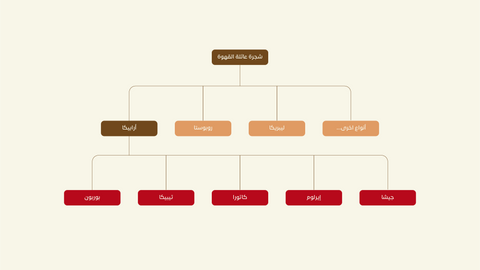Specialty coffee varieties are considered like a family tree, with many branches, and each branch (variety) has a different quality and taste that sets it apart from the other branches. Therefore, it is very important to familiarize yourself with coffee varieties so that you can distinguish between different crops and choose the one that suits you best.
Coffee crops are divided into several categories, the most famous of which are Arabica and Robusta, followed by Liberica. Each of them differs from the others, but the most well-known and widely used type is Arabica coffee, which is considered the specialty coffee and is distinguished by its nuances and flavors compared to Robusta and Liberica, which are generally more bitter than Arabica. In this article, we will discuss in detail the family tree of Arabica and its varieties, as well as the differences between them.

Flavors from Each Continent
In the past, continents located in the coffee belt, namely Africa, Asia, and Latin America, were known for specific flavors and nuances that distinguish each continent from the other. This difference is primarily due to the varieties that grow in each continent; depending on the variety, the nuances vary. However, over time, as trade routes evolved and began connecting the world, these varieties migrated from their native countries to other countries in different continents. As a result, distinguishing the origin of diverse crops has become challenging. For instance, we may taste a crop from Asia today that has nuances similar to those prevalent in Africa, leading to a new revolution in the world of coffee.
This evolution has also given the opportunity to some other varieties, such as the Geisha variety, which has its origins in Ethiopia. However, coffee farmers in Panama, a country in Latin America, focused on developing and nurturing Geisha trees to impressive levels, making Panama the first name that comes to mind when mentioning "Geisha," despite the fact that the origin of this variety is Ethiopia!
Continent of Asia
Crops coming from the Asian continent are known for being lower in acidity and having nuances reminiscent of cinnamon and tobacco, with a light body.
Continent of Latin America
Crops from Latin America are characterized by flavors that mimic chocolate and nuts, with a sweet taste, balanced acidity, and a full body—this is the classic coffee flavor.
Continent of Africa
The African continent is distinguished by its crops that exhibit floral and fruity flavors, with high acidity and a somewhat syrupy body.

Arabica Coffee Varieties
The Bourbon, Typica, and Heirloom varieties are considered the most famous and widely produced Arabica varieties. From these, other varieties have branched out as a result of crossbreeding some varieties with others.

Bourbon Variety
The Bourbon variety is the most famous among Arabica coffee varieties and is the most widely produced globally. Its origin traces back to Africa, but over time, as trade routes evolved, this variety spread to other countries and regions, leading to its cultivation in Asia and South and Central America. The Bourbon variety is characterized by more complex and sweeter nuances compared to the Typica variety. There are several natural mutations of Bourbon that produce sub-varieties, such as Yellow Bourbon, Red Bourbon, and Pink Bourbon, which make up a small portion of the overall production of the main Bourbon variety but boast flavors and nuances that are worth experiencing.
Typica Variety
Typica is one of the most common varieties and ranks second after Bourbon, with Typica's production being about 30% less than that of Bourbon. This variety originated in Latin America and is known for its sweet nuances and exceptional quality, in addition to being free from impurities.
Caturra Variety
After Caturra trees were introduced for cultivation in Brazil, a mutation of this variety resulted in smaller coffee cherries and higher productivity compared to the parent Bourbon variety. This variety was named "Caturra" after the city where it first appeared, which is Caturra in Brazil. Due to the smaller size of the coffee cherries, the tree produces more coffee cherries than the original Bourbon trees, which has made it very popular among farmers.
Heirloom Variety
In fact, Heirloom is not a variety but a term that refers to the heritage of Ethiopian coffee, which is characterized by its multitude of varieties estimated to be between 6,000 to 10,000. Each village had its unique method of pollinating coffee trees, primarily relying on a type called mixed pollination, where two different coffee varieties were blended during pollination. This process resulted in the large number of varieties in Ethiopia, with each village having its unique and distinctive variety. This has made it difficult to name each specific variety, leading to the term "Heirloom" or "Ethiopian Heirloom," which means Ethiopian heritage.
Geisha Variety
The Geisha variety is part of the Ethiopian Heirloom varieties, with its origin traced back to the village of Geisha in Ethiopia. However, as is commonly known among specialty coffee enthusiasts, the name "Geisha" has become mentally associated with Panama, which offers unique crops of this variety. But why has Panama always been a leader in the production of Geisha crops despite it being of Ethiopian origin?
This is because farmers in Panama introduced trees of this variety from Ethiopia and worked diligently to develop and nurture them. The climate conditions in Panama, which differ from those in Ethiopia, also had a significant impact on the variety, giving Panama's Geisha crops distinctive flavors and nuances not found in Ethiopian Geisha coffee. This has made them one of the most sought-after varieties by coffee lovers worldwide and reinforced the association of the Geisha name with Panama.




